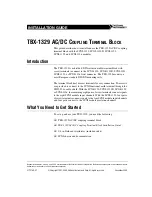
©
National Instruments Corporation
5
TBX-1329 Installation Guide
3.
V
drop
= 11.6 mV
⇔
0.3% of 3.333 V excitation.
You then need to calculate the voltage drop across the field signal wires you
are connecting to the TBX-1329. Perform similar calculations for your field
wires as you did for your cable. Resistance can vary depending on your
cable and field wires. Add this error amount to the voltage drop across the
SH32-32-A cable to get a total voltage drop.
You can compensate for this error along with any additional cable lead
resistance introduced by the strain-gauge connection wires. One simple
way of compensating is to calculate the lead resistance as shown in Steps 1
through 3, then input it along with your other strain-gauge parameters into
the conversion formula in your National Instruments data acquisition
software packages. In order to minimize resistive compensation, locate the
load closer to your SCXI module by using shorter cable lengths, or use
heavy-gauge wire to connect to the TBX-1329.
Measuring Current
To measure current with the TBX-1329, you can place a current loop
receiver resistor in the sockets on the TBX-1329. Table 1 shows the
TBX-1329 socket assignment per channel.
Caution
Use only National Instruments SCXI process current resistor kits for current
measurements.
Table 1.
Socket Assignments per Channel
Channel Number
Resistor Designator
0
R0
1
R1
2
R2
3
R3
4
R4
5
R5
6
R6
7
R7


































